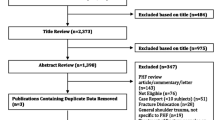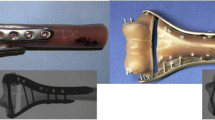Abstract
Introduction
This study was designed to test whether the number of impacts, the experience of the surgeon or impact force made significant difference in pull off forces.
Materials and methods
The forces applied by 10 orthopaedic surgeons (five residents and five attending staff) to impact the femoral head onto the trunnion of a femoral component were recorded. The resultant forces were then divided into four energy levels and compared to determine if the number of impacts would make a difference in pull off strength.
Results
No significant differences existed between the resident versus attending groups in magnitude of force applied. Through ANOVA testing, it was found that at each of the energy levels, multiple blows demonstrated a significant pull off strength difference compared to a single blow. Increased pull off force was also noted when the magnitude of force of the applied blows was increased.
Conclusion
We recommend at least two firm, axially aligned blows to impact the femoral head onto the trunnion intra-operatively.




Similar content being viewed by others
References
Pennock AT, Schmidt AH, Bourgeault CA (2002) Morse-type tapers: factors that may influence taper strength during total hip arthroplasty. J Arthroplasty 17(6):773–778
Shareef N, Levine D (1996) Effect of manufacturing tolerances on the micromotion at the Morse taper interface in modular hip implants interface in modular hip implants using the finite element technique. Biomaterials 17:623–630
ASTM (2000) Designation F2009–00 standard test method for determining the axial disassembly force of taper connections modular prostheses. 13(1):1484–1486
Fuji Corporation; http://www.fujiprescale.com/html/fuji_prescale.html
Abel Software Corporation; http://www.ablesw.com/3d-doctor/
Collier JP, Mayor MB, Williams IR et al (1995) The tradeoffs associated with modular hip prostheses. Clin Orthop 311:91–101
McCarthy JC, Bono JV, O’Donnell PJ (1997) Custom and modular components in primary total hip replacement. Clin Orthop 344:162–171
Collier JP, Surprenant VA, Jensen RE, Mayor MB (1991) Corrosion at the interface of cobalt-alloy heads on titanium-alloy stems. Clin Orthop 271:305–312
Barrack RL, Burke DW, Cook SD et al (1993) Complications related to modularity of total hip components. J Bone Joint Surg BR 75:688–692
Pellicci PM, Haas SB (1990) Disassembly of a modular femoral component during closed reduction of the dislocated femoral component: a case report. J Bone Joint Surg Am 72:619–620
Woolson ST, Pottorff GT (1990) Disassembly of a modular femoral prosthesis after dislocation of the femoral component: a case report. J Bone Joint Surg Am 72:624–625
Chandrasekaran V, Sauer WL, Taylor AM, Hoeppner DW (1999) Evaluation of the fretting corrosion behavior of the proximal pad taper of a modular hip design. Wear 231:54–64
Chu Y-H, Elias J, Duda G, Frassica F, Chao E (2000) Stress and micromotion in the taper lock joint of modular segmental bone replacement prosthesis. J Biomech 33:1175–1179
Goldberg JR, Gilbert JL (2003) In vitro corrosion testing of modular hip tapers. J Biomed Mater Res Part B: Appl Biomater 64B:78–93
Schmidt AH, Loch DA, Bechtold JE, Kyle RF (1997) Assessing Morse taper function: the relationship between impaction force, disassembly force, and design variables. In: Marlowe DE, Parr JE, Mayor MB (eds) Modularity of orthopaedic implants, ASTM STP 1301. American Society for Testing and Materials, West Conshohocken, p 114
Acknowledgments
The authors would like to thank Akron General Medical Center for their financial support, and Smith and Nephew (Memphis, TN, USA) for donation of the implants.
Author information
Authors and Affiliations
Corresponding author
Rights and permissions
About this article
Cite this article
Heiney, J.P., Battula, S., Vrabec, G.A. et al. Impact magnitudes applied by surgeons and their importance when applying the femoral head onto the Morse taper for total hip arthroplasty. Arch Orthop Trauma Surg 129, 793–796 (2009). https://doi.org/10.1007/s00402-008-0660-4
Received:
Published:
Issue Date:
DOI: https://doi.org/10.1007/s00402-008-0660-4




